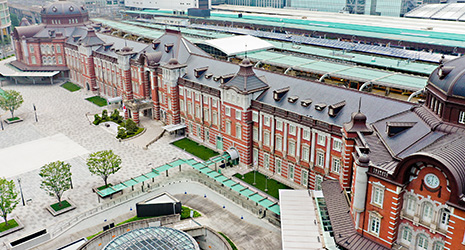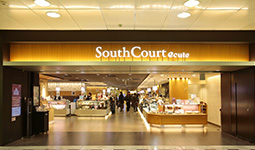February 2022
- English
- 日本語
Another Face of Tokyo Station, Japan’s Terminal Station

Tokyo Station 
The digital signage at Square Zero

The Ecute Tokyo ekinaka mall 
Example of souvenir sweets on sale at Tokyo Station (inspired by the station’s bricks) 
An exhibition of Aomori Nebuta Festival-related artwork at Square Zero. (See “Rousing Summer in Tohoku,” Highlighting Japan September 2011)

Tokyo Station is the center of Japan’s railway network and serves an average of about 460,000 passengers every day (FY2019), with about 3,000 daily train arrivals and departures, including railways connecting major cities across the nation, such as the Tokaido Shinkansen and the Tohoku Shinkansen. Tokyo Station continues to evolve not only as a terminal station but also as a shopping destination.

In recent years, new commercial spaces have opened one after another, mainly in major stations in urban areas, where you can enjoy shopping and eating and drinking in specialty stores. These commercial spaces, or malls, which have been developing rapidly since the 2000s, are called “ekinaka,” and their main characteristic is that they are located inside the ticket gates.
While there are many ekinaka at JR Tokyo Station, the gateway to Tokyo, more than 200 stores can be found in four ekinaka as follows: Gransta Tokyo, which opened in August 2020; Ecute Tokyo and Ecute Keiyo Street (currently under renovation) of Ecute, an ekinaka brand which can be found in East Japan Railway Company (JR East) stations in the Tokyo metropolitan area; and Gransta Marunouchi outside the ticket gates. These facilities are filled with all sorts of stores, including fashion brand stores, shops where you can buy dinner side dishes to bring back home, and sophisticated Japanese and Western confectionery stores. This is why the station has become an attractive place for shopping for people, not just a place to take the train. In the past, people would hurry to work in the morning and rush to get home again in the evening. Now, if they have a little time to spare, they stay and enjoy the ekinaka on their way home. (The ekinaka are all implementing rigorous anti-COVID-19 measures at this time.)

A PR officer at JR East says, “Gransta Tokyo, whose slogan is ‘TRY NEW TOKYO ST.,’ is Japan’s largest ekinaka with about 150 stores. Not only can you have meals at long-established and famous restaurants from all over the country, but you can also find many new Tokyo souvenirs that are only available here, so we’ve had a great response.”
One thing that makes Tokyo Station attractive is the many restaurants using fresh seafood and vegetables acquired that same morning from all over Japan thanks to the Shinkansen and other parts of the high-speed logistics network that goes to Tokyo. Ecute Tokyo, which is close to the Shinkansen platforms, has plenty of souvenirs and ekiben (lunch boxes to eat on the train). Moreover, Ecute Keiyo Street, with its many restaurants and shops geared to commuter needs, is designed to be a relaxing space like a park. In the passageways of Gransta Tokyo, traditional crafts such as Edo kiriko (glassware), Tokyo cloisonné (enamelware) and Edo noren (room dividers/curtains) are displayed as decorations, casually creating a Tokyo-esque atmosphere. Meanwhile, Square Zero, whose creation coincided with the opening of Gransta Tokyo, is a multipurpose event space with an atrium. Here various types of information are disseminated through digital signage* about 6.9 meters high, and a variety of events such as farm shops and presentations of Japanese culture are organized to make this a new interactive space at Tokyo Station, where people are given opportunities to meet and connect.

The JR East PR officer describes the future vision of Tokyo Station as follows. “With the evolution of ekinaka, the station has changed from being a transit point for travelers and commuters to a place where people gather. Further, based on the concept ‘Tokyo Station Becomes a City,’ Tokyo Station City Management Council aims to further enhance the appeal and value as ‘Tokyo Station City’ which is one large town that is centered on the station and connects surrounding areas like Marunouchi, Yaesu and Nihonbashi.”

The station used to focus on quick-service stores such as kiosks and fast-food places to meet the needs of people just passing through but has now been transformed into a place with many attractive shops that is a shopping destination in its own right. There is also an art museum inside the station, while concerts of various genres are held on a station plaza, allowing people to enjoy cultural events as well as shopping.
In 2001, IC cards were introduced that could be used not only for paying for rail fares, but also for shopping. Taking advantage of this, Tokyo Station has been creating rich, enjoyable spaces that connect people beyond the station’s function as a key transportation hub by expanding the ekinaka. Tokyo Station is developing its various services and continues to evolve.
* General term for media that conveys information using displays and other electronic imaging devices in transportation facilities, public spaces, and other locations

